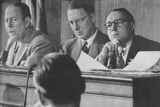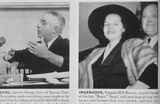 Kefauver hearings - senators O'Conor, Kefauver, counsel Rudy Halley, from Life 1951/04/06
Kefauver hearings - senators O'Conor, Kefauver, counsel Rudy Halley, from Life 1951/04/06
|
 watching Kefauver hearings at blood bank 1951, from Life 1951/04/06
watching Kefauver hearings at blood bank 1951, from Life 1951/04/06
|
 George Levy and Virginia Hill at Kefauver hearings, from Life 1951/04/06 - 2
George Levy and Virginia Hill at Kefauver hearings, from Life 1951/04/06 - 2
|
 Kefauver hearings - Joe Adonis watches Costello's hands, from Life 1951/04/06
Kefauver hearings - Joe Adonis watches Costello's hands, from Life 1951/04/06
|